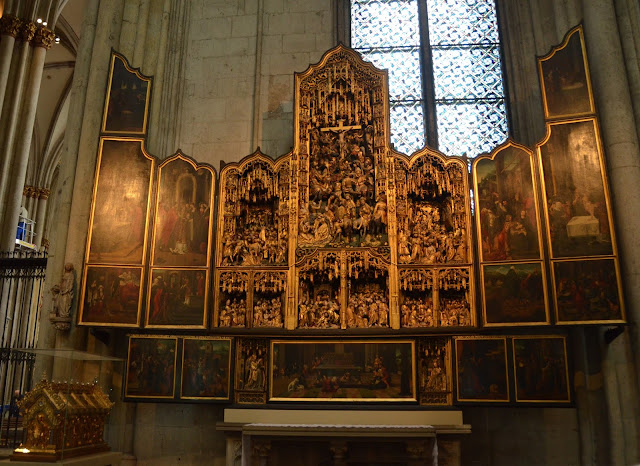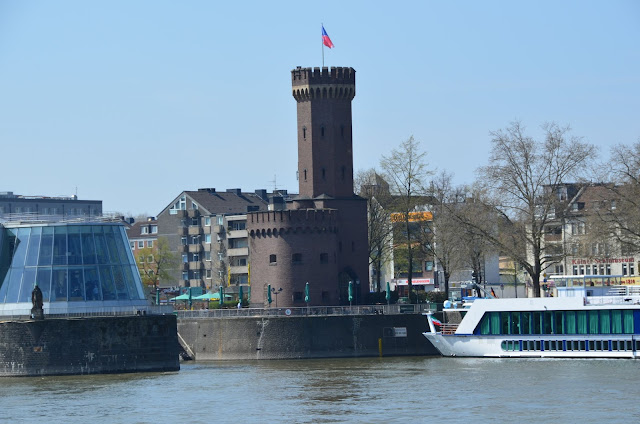In April 2013, I had the opportunity to attend a database conference (NoSql Matters) in Cologne (Köln), Germany. Linette hadn't been to Europe before, and we had just enough frequent flier miles to get her to Amsterdam, so we decided to meet there after my conference, and also to visit our friends Dan and Marcia Ventura while they were on sabbatical in London.
So on April 22, 2013, I flew to Cologne, Germany. I went a day and a half early so I could see a few things, and also to recover from jet lag so I could be awake during the conference.
One of the most impressive things in that city is the Dom cathedral, which was the tallest building in the world up until the Eiffel Tower was built. It is twice the height of the Salt Lake Temple.
The building is very ornate. It took some 600 years to complete, and amazingly avoided extensive damage during World War II.
The stained glass windows are beautiful and portray various episodes from the scriptures.
I grabbed some local fast food, including some sausage with a spicy sauce; a hard roll; and some french fries.
Cologne (Köln) comes from a word meaning "Colony", because it was established by the Romans in about 50 A.D. at the frontier of their empire, as a fortified town on the river to act as a stronghold.
Because of its history, Roman architecture and artifacts continue to be found around town whenever anyone does any construction. Here are some cool statues recovered in Cologne.
There were some great street performers around town.
After walking around until my feet hurt the first afternoon in Cologne, I decided the next morning (April 24, 2013) to rent a bike for the day. Once I got on it and started pedaling, I thought "Wheeeee!!!" and it was so much nicer than having to walk everywhere. It gave me the freedom to explore a lot more of the town.
Approaching one of the main bridges across the Rhein River, I saw that the steps up to the sidewalk along the bridge had a little ramp you could use to walk your bike up it.
There were locks locked onto the fence along the bridge. The idea is that you put the name of you and your sweetheart on a lock, lock it to the bridge, and then throw the key in the river, showing that your love is forever.
There were locks all along the bridge, which was impressive.
There were great bike paths along the river, and it was a beautiful day.
I loved the narrow cobblestone streets.
As I rode the bike around, I happened on this 11th-century Romanesque church called St. Maria im Kapitol (St. Mary's in the Capitol). It was built from 1040 to 1065, and down in the church's crypt can be seen some foundations from a church built in 690 and a Roman temple built in the 1st century A.D. I didn't go inside, but I thought the round walls of the exterior were really cool.
Cologne was a fortified city on the boundary of the Roman empire. The walls have been torn down (and the stone likely repurposed for other buildings). But the gates are still intact.
The hedges at this park reminded me of the hedge maze in "Go Dogs, Go!"
There was a great paved path along the river to ride on.
From the opposite side of the river, it was more clear how much the Cologne Cathedral ("Dom") towered over the rest of the town.
Across the river, I saw a tour boat, and decided to go check it out.
I ended up hopping on board and taking a little ride up and down the Rhine River.

It was fun seeing the bridges and buildings along the way.

These buildings were built leaning way over the water. That's pretty cool, though it would make me nervous to be in those.
The above wall was part of the actual Praetorium, which was the Roman leader's headquarters, and next to it is a model showing what it would have looked like originally.
In one section, they were very careful to remember exactly where they found each bit of pottery, and then suspended it by strings to put it in the same place after the dirt was removed.
Here is a map showing what the ancient Roman fortified city of Cologne looked like back around 100 A.D.

And here is a model showing the city at a later time, before the wall was taken down.
I thought it was cool that after 2000 years, you could still read the letters on the artifacts. (They used all upper case, and used "V" for "U", but otherwise used the same alphabet),

Another museum down the street, called the Kölnisches Stadtmuseum (Cologne City Museum), had displays of weapons and armor.
A long park surrounded the town in a ring that is just outside the original city walls.
This statue looked like he was really bummed, so I joined in to commiserate.
This curved metal wall allowed me to take a selfie.
The ambulances were painted a fluorescent orange.
That evening there was "kirchenmusik" (church music) at the Dom (the main, tall cathedral). There was a big choir and an orchestra, and the music sounded amazing echoing around inside that massive cathedral. A lady sang at one point and sounded like an angel.
When I came out of there, I stumbled across a small band of street performers. They were astoundingly good. The band oddly consisted of a violin, a squeeze box, an accordion, and a tuba, which makes you think you're going to hear polk music. You're not. The main guy played a violin as good as any I've ever heard, and it appeared he wasn't even close to the boundary of his talent. When I walked up, they were playing a selection from Vivaldi's "The Four Seasons", and I was mesmerized.
Here's a 1-minute clip to give you an idea.
Later they played Toccata and Fugue in D Minor by Bach, with the squeeze box doing a great job of simulating an organ, the tuba adding the depth of the organ pedals, and the violin emphasizing the melody. Again, it may sound odd, but it was deeply impressive. I bought a CD from them and then sat and watched until they were finished.
(If you want to watch them play Toccata and Fugue in D Minor, here it is. It goes for 7 minutes, so you can stop after the "Toccata" part if you want).
Their group is called The Compatible, and they are from Russia. They mentioned that they had been playing at the Rijksmuseum (in Amsterdam, The Netherlands) the week before, so apparently they play in various places around Europe. (A couple years later, I watched a movie called "The Fault in Our Stars", which tells the story of a girl with cancer whose dream was to go to Amsterdam. When she got there, this very same band appeared in the movie, playing on the streets!)
My conference started the next day, and I enjoyed hearing what was going on in the industry. (The buzz clearly confirmed FamilySearch's plan to switch from MongoDB to Cassandra, which was helpful).
It was funny the night before when I attended a tutorial, because the guy got up and started speaking all in German, and I thought, "Uh...I hate to be naive or expect everyone in the world to learn my language, but I was sort of expecting this conference to be in English..." Soon the guy noticed a few blank stares from people from several countries, and apologized and switched to English. Somehow we won the lottery and all the international conferences (and cruise ships) speak English.
Since I was presenting a paper, I got invited to the speaker's dinner, and I had fun talking to a guy from Catalonia (which includes Barcelona and is currently part of Spain, though they're grumpy about that).
The traditional German food was excellent.
Parking is at a premium in most towns in Europe, especially since the roads were often designed long before modern traffic needs. These tiny Smart cars are the only ones that can fit in some parking spaces.
This time a guy with a huge triangle bass joined them. I sat and watched them for quite some time.
Here is a short video clip of them playing some more Vivaldi.
My conference started the next day, and I enjoyed hearing what was going on in the industry. (The buzz clearly confirmed FamilySearch's plan to switch from MongoDB to Cassandra, which was helpful).
It was funny the night before when I attended a tutorial, because the guy got up and started speaking all in German, and I thought, "Uh...I hate to be naive or expect everyone in the world to learn my language, but I was sort of expecting this conference to be in English..." Soon the guy noticed a few blank stares from people from several countries, and apologized and switched to English. Somehow we won the lottery and all the international conferences (and cruise ships) speak English.
Since I was presenting a paper, I got invited to the speaker's dinner, and I had fun talking to a guy from Catalonia (which includes Barcelona and is currently part of Spain, though they're grumpy about that).
The traditional German food was excellent.
Parking is at a premium in most towns in Europe, especially since the roads were often designed long before modern traffic needs. These tiny Smart cars are the only ones that can fit in some parking spaces.
That day after the conference, I walked around town and came across The Compatible again.
This time a guy with a huge triangle bass joined them. I sat and watched them for quite some time.
Sunday morning I took the train to go to church. It was amazingly quiet as I walked through town that morning.
The path I took to the church took me through some pretty neighborhoods with adorable houses, gardens and parks.

I enjoyed church. I pulled up the lesson in English so I could follow along, and a guy on the high council translated what was going on into English for me on occasion. One of the talks in sacrament meeting was given in English (by a guy from Romania or somewhere) and translated into German by the guy's fiancée.
After church I took the train back to my hotel and quickly changed (since they were nice enough to let me do a late check-out), and then went to the Hauptbahnhof (main train station) to take a train to Amsterdam.
While I waited, I saw this couple who were so sad to be parting. They kept hugging and kissing and then stood at the door of the train until the last possible moment. I'm not sure what their story was, but it was cute.
In the next episode, I meet up with Linette and we explore the beautiful streets and waterways of Amsterdam. And attend the biggest party in the world!
















































No comments:
Post a Comment